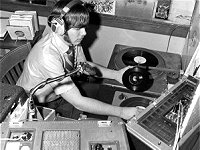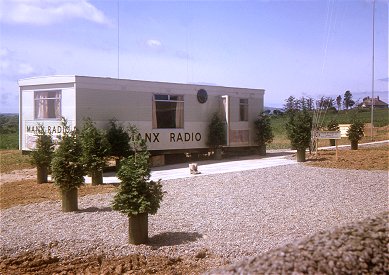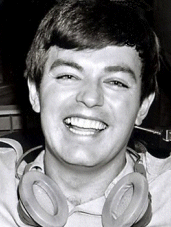


|
 |
|
|
The
BBC, Local Radio
and Onshore Stations The American sounds of rhythm and blues and highly charged rock'n'roll hit Britain in a big way during the mid to late Fifties. The staid old establishment of the BBC failed to recognise, or ignored, its broadcast potential and made very little effort to convey these new sounds to the public despite the potentially huge youthful British audience who wanted as much of it as they could get. Instead, it stuck to the tried and tested formula of a mixture of soaps, comedy programmes, quiz shows and light or classical music. Its output consisted of three main 'channels': The Home Service (which was Radio 4 style), The Third Programme and Network 3 (Radio 3 style) and the Light Programme (Radio 2 style). The first two entertained the middle-aged, middle and upper-class audiences with various types of programme and comedy offerings like The Clitheroe Kid, together with more classical and traditional music programmes which did not particularly appeal to the new youth culture. The Light Programme was the only one that made even a token attempt at youth programming, offering mainly trad jazz and skiffle, but was generally hosted by presenters who were uncomfortable with the material. BBC music entertainment shows in the late Fifties and early Sixties consisted of such offerings as 'Worker's Playtime', 'Pop Inn', '12 O'Clock Spin' and the slightly more youth-oriented 'Drumbeat' and 'Go Man Go' - "your Friday tonic, the show with the most". The latter was presented by 'your swinging man Friday' David Ede and was broadcast live from the BBC Playhouse in London, featuring resident session bands such as Bob Millar and His Millarmen, Arthur Greenslade and The G-Men, and Colin Day and The Hound Dogs who played a half-and-half mixture of 'pop' music and standards. Both of these shows originally entertained a live studio audience and Drumbeat even contained an early version of 'Juke Box Jury'. The BBC did make a couple of minor concessions to the new music culture with a programme on Saturday mornings called 'The Saturday Skiffle Club' (later to drop the 'Skiffle') and a review of the singles record chart on Sunday afternoons (although more short-lived shows were eventually added at various times during the Sixties to try and compete with the emerging 'pirate' phenomenon). |
|
|||||
    |
Even
in this, the shows were hosted by presenters, like Don Moss, who were
more used to the usual BBC output, making
the end result rather uninspired. Things improved slightly in 1961 when
Alan 'Fluff' Freeman took over Sunday's
'Pick Of The Pops' slot from the more sedate David Jacobs but his upbeat
style was not particularly to the taste of the corporation management
and he was not infrequently requested to 'tone it down'. The following
year saw another programme called 'Teenager's Turn - Here We Go' on which
The Beatles made their radio debut in March 1962. There were few alternatives, the best of which was probably in frequenting one of the multitude of small coffee bars with the obligatory jukebox that sprang up ever faster around this time although they were not a new phenomenon. Other than that there were the 'listening booths' at your local record shop or, if you happened to live near the east coast, you could try tuning your wireless to Radio Luxembourg which was coming in from across the North Sea on 208 metres medium wave. The only snag being that the signal fluctuated a lot and it could only be received between about 7p.m. and 3a.m. Some shows frequently heard were a Merseybeat feature called 'Saturday Night at The Cavern' and a programme called 'Swingtime' which went out on Sundays at about 9 p.m. It was from Luxembourg that Keith Fordyce introduced us to the 'power play'. |
| Major record companies such as Decca, Columbia, Philips, Capitol, Warner Brothers and E.M.I. paid huge amounts of money to sponsor 15 or 30 minute time slots on the station and because of this generally only the first 30 seconds or so of a record were played, linked by a 'live' disc jockey doing quick intros, in order to get as many of their artists and new records as possible into the time allocation. This was sometimes as high as 13 or 14 records crammed into a 15 minute 'slot'. Many of the shows were pre-recorded at London's Hertford Street studios and a typical night's programming consisted of 30 minutes of singles, 30 minutes of L.P. tracks followed by lighter music until 'Music In The Night' came on at midnight, catering to a much wider selection of tastes. On Sundays at about 11p.m. Barry Aldis hosted a 'Top 20' show. The station also produced its own weekly magazine, 'Fabulous 208', a feature which was to be emulated by the major offshore 'pirates'. |
| The early Sixties
saw mainland Europe address the lack of youth-oriented shows in their
own countries by setting up privately-owned offshore 'pirate' radio stations
to broadcast the music that they wanted to hear, transmitting unlicensed
broadcasts from ships anchored outside territorial waters. 1960 saw the launch of Radio Veronica and, within a few years, it was followed by Radio Nord, Radio Mercur and Radio Syd who covered some Scandinavian countries. Belgium had Radio Antwerpen for a short while and Radio Veronica, soon joined by Radio Nordzee, was belting it out to the lowland countries from off the coast of Holland. This was great for the mainland of Europe but the signal strength these stations generated wasn't high enough to reach over here with the exception of Radio Veronica which could sometimes be picked up on the east coast when conditions permitted. With the BBC failing to cater adequately for the new 'beat generation' and the limited reception quality from the European stations the only apparent (some would say obvious) solution was for someone to start a brand new station a bit nearer to home. At the start of the Sixties there had been some considerable pressure on the British government to issue licences to land-based commercial stations but none seemed to be forthcoming. |
 |
| One of the more persistent lobbyists was T.H. Colbourn who was a member of the Manx parliament, Tynwald, and whose radio and television company serviced a large proportion of the island's communications. Another major supporter was Sir Ronald Garvey, the island's Lieutenant-Governor, who had been instrumental in setting up a local radio station in his time as Governor of Fiji. Technically, Manx Radio did not need a broadcasting licence from the UK authorities as it was a Crown Dependency and not part of the United Kingdom, but after two years of negotiations with the Home Office and other bodies success was finally achieved when the GPO agreed to issue a licence for a local station which could only be heard within the confines of the island. |
 |
The telecommunications
company PYE were to build the station but it was still forced, by the
licence conditions, to use a VHF transmitter even after an earlier offer
of a medium-wave frequency of 1594 kilocycles had been rejected on technical
grounds.
The man
employed to manage the station was Richard Meyer who had previously
been manager of the International Broadcasting Company (which had organised
the start of Radio Luxembourg before World War II) and the commercial
manager of Associated television (ATV).
From the
outset he was less than enthusiastic about using VHF as there were comparatively
few receivers for this medium around at the time. Nevertheless, test
transmissions were carried out initially on VHF, the first broadcast
being a commentary on the Isle of Man T.T. of 5th June 1964. The station
continued throughout the summer in stereo on FM 89.0 MHz.
|
|
|
As if finally realising
the size of the potential audience that it had been ignoring, the BBC
completely revamped its setup, announcing its future plans in December
1966. The Home Service became Radio 4, The Third Programme and Network
3 became Radio 3 and The Light Programme became Radio 2 on long wave.
Light
programme closedown. |
 |
|
|
Radio 1 initially employed
about 33 disc jockeys (or 'presenters' as they were known) of which
more than half were ex-pirates, many of whom had already transferred
to the BBC's Light Programme. Radio London provided 11, Radio Caroline
4 plus Radio Scotland's Stuart Henry and Mike Raven of Atlanta, King
and 390. With a large proportion of them having worked previously on
Radio London there was a tendency for Radio 1 to have the same style
of presentation, even down to the sound of the jingles. |
| Radio Leicester | 12.45 pm on 8th November 1967 |
| Radio Sheffield | 15th November 1967 |
| Radio Merseyside | 22nd November 1967 |
| Radio Nottingham | 31st January 1968 |
| Radio Brighton | 14th February 1968 (later BBC Sussex) |
| Radio Stoke | 14th March 1968 |
| Radio Leeds | 24th June 1968 |
| Radio Durham | Opened 31st July 1968, but after government restriction to 20 stations, closed 25th August 1972. Resources transferred to Radio Carlisle (now Cumbria). Only original station to cover a county rather than a city |
| Radio Manchester | 10th September 1970 |
| Radio Bristol | September 1970 |
| London Radio | 6th October 1970 |
| Radio Oxford | 29th October 1970 |
| BBC WM (West Midlands) | 9th November 1970 |
| Radio Kent | 18th December 1970 |
| Radio Solent | 31st December 1970 |
| Radio Tees | 31st December 1970 |
| Radio Newcastle | 2nd January 1971 |
| Radio Lancashire | 26th January 1971 |
| Radio Humberside | 25th February 1971 |
| Radio Derby | Officially began 29th April 1971 but went on air two months earlier than planned to cover the bankruptcy of Rolls-Royce |
| LBC and Capital Radio | Commercial stations, October 1973 |
| Radio Cumbria | 24th November 1973 |
| Radio Clyde | Commercial station, December 1973 |
| Subsequent station openings included: | |
| Radio Norfolk | 11th September 1980 |
| Radio Lincolnshire | 11th November 1980 |
| Radio Jersey | 15th March 1982 |
| Radio Guernsey | 16th March 1982 |
| Radio Cambridgeshire | 1st May 1982 (originally known as Radio Cambridge) |
| Radio Northampton | 6:45am on 16th June 1982 |
| Radio Devon | 17th January 1983 |
| Radio Cornwall | 17th January 1983 |
| Radio York | 4th July 1983 |
| Radio Shropshire | 23rd April 1985 |
| Three Counties Radio | Launched as BBC Radio Bedfordshire on 24th June 1985 - changed name 5th April 1993 |
| Radio Essex | 5th November 1986 |
| BBC Somerset | 11th April 1988 |
| Radio Gloucestershire | 3rd October 1988 |
| BBC Hereford and Worcester | 14th February 1989 |
| BBC Wiltshire | 4th April 1989 |
| BBC Coventry and Warwickshire | January 1990 |
| Radio Suffolk | 12th April 1990 |
| Radio Surrey | 14th November 1991 (later just BBC Surrey) |
| Radio Berkshire | 21st January 1992 |
| BBC Dorset | 1993 to 1996 |
| Southern Counties Radio | 1st August 1994, formed by the merger of BBC Radio Sussex and BBC Radio Surrey. Radio Sussex founded 14th February 1968 as BBC Radio Brighton. It expanded to cover the whole of Sussex in October 1983 |
| Radio Surrey originally planned as a stand-alone station, launched on 14th November 1991 as a limited opt-out service of BBC Radio Sussex | |
| BBC Thames Valley | 9th April 1996 following the merger of BBC Radio Oxford and BBC Radio Berkshire. The merged station was not popular with listeners and the two original stations were reinstated on 14th February 2000 |
| Other Significant Radio Events: | |
| 28th August 1962 | Experimental stereo radio broadcasts begin |
| 1st October 1963 | BBC to receive full benefit of £4 combined licence as government relinquishes its £1 duty |
| 15th July 1964 | The Post Office tower, under construction since 1961, is topped out |
| 22nd March 1965 | Launch of the daytime BBC Music Programme on the frequencies of Network Three / the Third Programme |
| 1st May 1965 | The General Overseas Service is renamed the BBC World Service |
| 1st August 1965 | The broadcast receiving licence for radio is increased to £1 5s. Combined TV and radio licence is increased to £5 |
| 8th October 1965 | The Post Office tower is officially opened by Prime Minister Harold Wilson |
| 30th September 1967 | BBC Radio 1 pop music station is launched. The BBC Light Programme is renamed Radio 2, the evening BBC Third Programme and daytime BBC Music Programme are merged as Radio 3, the BBC Home Service becomes Radio 4 |
| 8th November 1967 | BBC Local radio starts with Radio Leicester |
| January 1968 | Tom Edwards replaces Simon Dee on Midday Spin |
| 14th February 1968 | Ed Stewart begins presenting Junior Choice |
| 25th April 1969 | The last Mrs Dale's Diary is broadcast |
| 28th April 1969 | The first Waggoner's Walk is broadcast |
| October 1969 | Terry Wogan presents his breakfast show on R1 & R2 and Pete Murray presents Open House |
I have no information
regarding copyright contacts for any pictures appearing here - I have seen
most of them in various locations with no copyright contact information.
I am using them to illustrate the articles purely for interest and fan purposes
with no intention of financial gain, but if I have upset anyone through
their use, please advise me and
I will either remove them or be only too pleased to give credit to the copyright
owner if that is acceptable. Radio station names (I assume) and logos remain
the copyright of the particular owners. Again, I only reproduce them for
interest purposes and the same condition applies. To anyone who does hold
copyrights on any of these and lets them stay on here, a very big THANK
YOU! I would also like to pay tribute to the authors of the many excellent
books and web sites I have looked at while putting this together as I can
now appreciate, even if only to a small extent, the amount of work involved.
I hope you get as much pleasure from reading it as
I did in researching and assembling it. ![]()
![]()
|
|
All
Original Material Copyright SixtiesCity
Other individual owner copyrights may apply to Photographic Images |